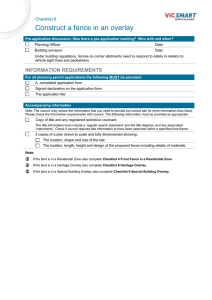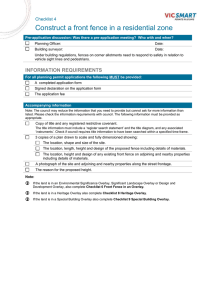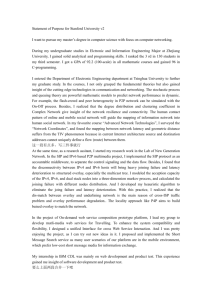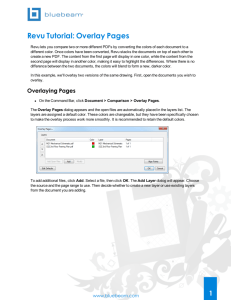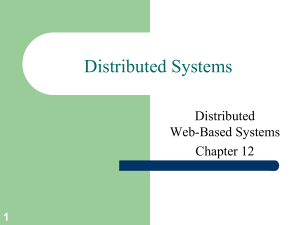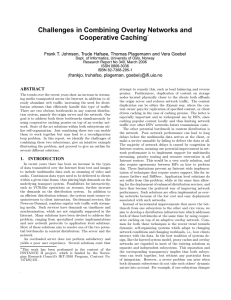The INSTANCE II project Frank T. Johnsen, University of Oslo
advertisement
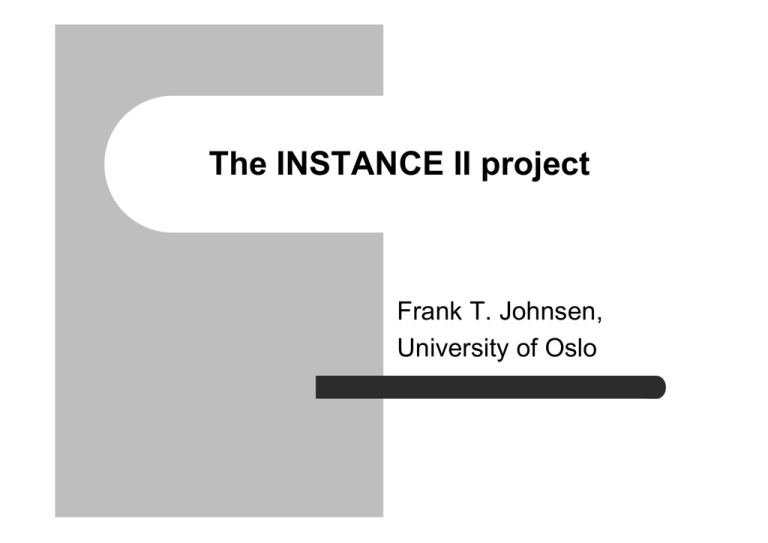
The INSTANCE II project Frank T. Johnsen, University of Oslo Overview Introduction Application area and project goal Overlay network example Partial caching Simulations The road ahead Introduction INSTANCE II builds on ideas from INSTANCE and KOMMSYS. INSTANCE is short for intermediate storage node concept (basically a proxy). The original project was Pål Halvorsen’s Ph.D. work. His kernel optimizations enhanced the proxy’s throughput. What is INSTANCE II? A distribution infrastructure. Work is done on the middleware level networking issues and cooperation between proxies. Focus is on mixed media rather than pure VoD. The project is financed by NFR. Application The application area for INSTANCE II is mixed media in a News-on-demand (NoD) scenario. Important differences from VoD: – – User interaction Structure Our news story assumptions: – – A news item may consist of several different objects. The relationship between objects is described by a presentation plan. Goal The project goal: – Enhanced delivery of mixed media content. Shall be achieved by: – – CDN with a reconfigurable overlay network (Trude Hafsøe), and partially caching proxies in this overlay (me). An overlay network A physical network – – Nodes (squares) and links (lines). An overlay network A physical network – – Nodes (squares) and links (lines). Some nodes are part of the CDN (red). An overlay network An overlay network – – The participating nodes (red). Virtual links between nodes (blue dotted lines). Note that virtual links are independent of physical links! An overlay network 12 7 12 16 The overlay links can be chosen according to some criterion, for example latency. An overlay network 500 X 12 12 16 The overlay links can be chosen according to some criterion, for example latency. If something happens the values will change. An overlay network X 12 30 12 16 The overlay links can be chosen according to some criterion, for example latency. If something happens the values will change. This might trigger an automatic reconfiguration. An overlay network In INSTANCE II we have different QoS classes. This warrants multiple overlay networks spanning the same nodes. Our CDN Why use an overlay network? – – – Easy to deploy and maintain. Possibility for application level multicast. Enables third parties (not ISPs) to offer enhanced services to their users. We envision one hosting CDN spanning multiple ISPs. What is partial caching? Different types of partial caching: – – Time domain Quality domain We want to introduce structure as well. Caching with structure Structure expresses relationships between multimedia objects. We will have two kinds of structure: – – Structure between objects Structure within objects We assume that a proxy utilizing knowledge about structure will be more efficient than a proxy that does not. I am looking into such a scheme for our scenario. Caching with structure Structure between objects: – For example that they are always retrieved: together, after one another, or as an alternative to the other. – They are a part of the same presentation plan. Structure within objects: – An example is layered video. Caching with structure Advantages of NoD: – – – Known structure. Re-use of elements. Interaction and access patterns. Structure caching example: – Branched VoD Each branch is eligible for caching. A master degree student is looking into this. Is this smart? Remains to be proven: – The CPU overhead may render it useless in a real system. My approach: – – Simulate it and estimate the overhead. Compare the performance gains to a simple yet relatively good reference algorithm, i.e., LRU. The road ahead Now: – Test hypothesis with a discrete event simulation. Next step: – Integrate this with the reconfigurable overlay network, and then add proxy cooperation to the model. Simulation ideas SERVER − infinite disk space Other assumptions: – − zero delay − unlimited bandwidth – PROXY − finite disk space − zero delay − unlimited bandwidth CLIENT – – The proxy has the presentation plan and does not need to retrieve this. A presentation plan has a unique ID. A media object (i.e. an object in a presentation) has a unique ID. The probability of accessing a news story (a presentation) is Zipf-like. The next step S P The INSTANCE II CDN: – – P P – – P Server (S) and proxies (P) in an automatically reconfigurable overlay network. Clients (small squares) connected to proxies. Routing of packets according to QoS class. Proxy cooperative caching. Highlights INSTANCE II – – – – – Multi-ISP hosting CDN. Automatically reconfigurable overlay network. Partial caching with structure. A distribution infrastructure for mixed media. Focus on interactive NoD. Thanks for your attention! Questions? Ask and be enlightened!

